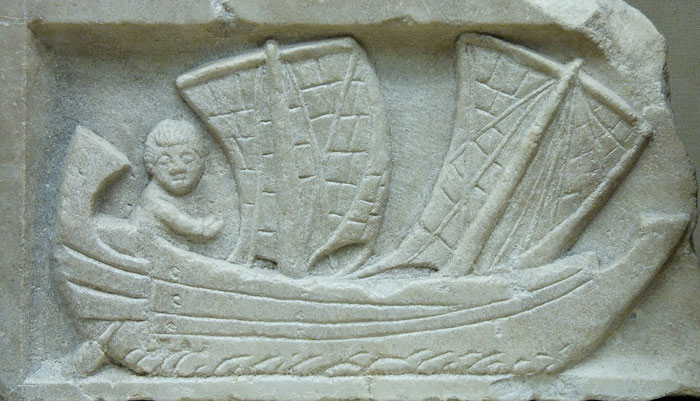The inventions that the Mesopotamian civilization left behind
Considered the "civilized cradle" of the world, the ancient Mesopotamian civilization left behind many valuable inventions.
Mesopotamia is the land between the Tigris and Euphrates rivers. Beginning to appear in southern Iraq for the first time, Mesopotamian civilization flourished on a large area including Iraq, Kuwait, eastern Syria, southeastern Turkey and southwestern Iran today.

Mesopotamia area - (Photo: Ancient Civilizations).
One of four civilizations arising along the world famous rivers along with the Nile Delta in Egypt, the Indian River Delta in India and the Yellow River Delta in China, the text Mesopotamia has left behind many valuable inventions.
60 and 1 hour counting system with 60 minutes

The ancient 3,700 tables of Babylonian clay records many methods of calculation.The table is currently kept at Columbia University Library, New York - (Photo: Andrew Kelly).
The people of Mesopotamia use the number counting system 60. From then on, the Mesopotamia divide 1 hour into 60 minutes and 1 minute consists of 60 seconds.
Thanks to the base 60, the circle is divided into 360 degrees.
Since ancient times, the ancient Mesopotamians knew how to do 4 calculations plus subtractions, knowing fractions, exponents, quadratic and base numbers. They knew how to make base tables to easily look up and know how to solve the problem. The process has 3 unknowns.
They knew the area of many images and knew the relationship between the three sides in the triangle long before the Pythagoreans (lived in the 500 BC) proved this.
12-month negative schedule

Mesopotamian residents rely on the Moon to make a 12-month calendar - (Photo: NASA).
Babylonian astronomers (part of Mesopotamia civilization) can predict eclipse periods and solstices during the year.
They also gave a 12-month calendar idea based on the Moon cycle. This is the basis for the lunisolar calendar that we use today.
Soon after, the Egyptians learned this 12-month calendar but applied it to the Sun.
Wheels and trailers

A picture of a Sume chariot in the 2500s BC - (Documentary).
Mesopotamia in the years 3000 BC were the first residents to create a means of transport thanks to animal traction. By about 2,000 BC, new trailers were imported into China.
The original tow truck was a 2 or 4-wheeled vehicle pulled by two or more horses tied close together, controlled by a coachman. The vehicle is used for many purposes such as transport, parade, sports competition and even in the war.
Tractors appearing in Mesopotamia civilization are also understandable when many researchers believe that it is the Mesopotamian people who created the wheel in 3,500 BC for production and transport activities.
Sailboat

Sailboat of ancient Mesopotamia - (Photo: Bright Hub Engineering).
Due to the need to trade goods, Sumerians found that traveling by road took a long time and could not transport large quantities of goods.
The Sumerians created a square boat with a high pillar attached to the cloth by the wind moving across the Tigris and Euphrates rivers.
In the beginning, however, the Sume didn't know how to adjust the sail direction. This leaves no less inconvenient when the wind direction is not in line with their direction.
Plow blades and agricultural breakthroughs

Simulation of plowshares of Mesopotamia - (Photo: Wacom Gallery).
Because of its location in the vast plain between the two rivers, agriculture is still the basic industry of Mesopotamian civilization. People here have many inventions for agriculture, one of which is plowing.
The first plow was made of wood, a simple shape in the 6,000 BC years.
In the beginning, the tools were often stuck with stones when plowing, so they had to remove the soil with their hands. The plowshare also does not work well in areas of overgrown grass. Gradually, Mesopotamian residents developed plowshares for better efficiency.
This invention contributes much to farming, ensuring a stable agricultural life instead of nomadic farming.
Map

Part of the world map of ancient Babylonians - (Photo: Wikimedia).
Mesopotamia is the earliest land use map in the world, in which the oldest map discovered dates back to 2300 BC.
This map is engraved on clay, depicting Akkadian land in Mesopotamia. Map used as city map, used in military or commercial.
Although he was an inventor, the level of making Mesopotamian maps was not equal to that of the Greeks and Roma later.
The first set of laws
Mesopotamia is also the region with the earliest codes right from the years 2200-2100 BC. These laws regulate property inheritance, adoption, land taxes, agricultural protection, farmers' responsibilities and penalties for fleeing slaves .
The most important law in ancient Mesopotamia is the law of Hammurabi of King Hammaura (1796 BC - 1750 BC) - the 6th king of Babylon. This is also the oldest law which is well preserved, dating back to 1760 BC.
This law currently only has a part carved on a high stone stele about 2.44m which is currently stored at the Louvre Museum (France). This is the earliest almost intact ancient law that has been discovered today.
Mesopotamia is also the first urbanized land (4300-3100 BC period).
- The important inventions of the Germans changed the world today
- 4,000-year-old marriage contract was discovered
- 10 interesting inventions of ancient Egyptians (II)
- Redefining the age of Indian civilization
- Civilizations of aliens?
- Doubts surrounding an 800-year-old mass grave in Peru
- The mystery of the tendency is 'off the left' that people don't recognize
- 15 quirky inventions but the idea is quite interesting
- Unique treasures of Egypt
- Mysterious ancient civilizations unknown
- Ever had a civilization in Antarctica?
- Secrets of left-handed people
 Daily use inventions come from universities
Daily use inventions come from universities Special weight loss device helps prevent appetite
Special weight loss device helps prevent appetite 8 inventors were killed by their own inventions
8 inventors were killed by their own inventions Iran invented a motor car powered by water
Iran invented a motor car powered by water